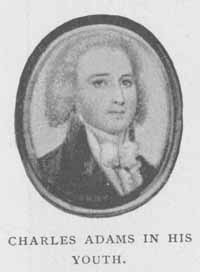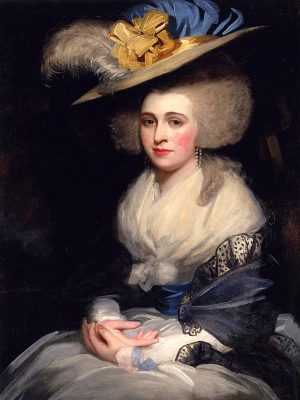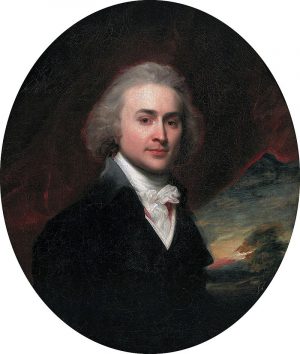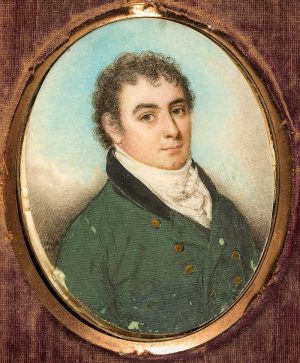John Adams had six children with his wife, Abigail Adams. Four lived to adulthood, one died before she was two years old, and one was stillborn.
Abigail “Nabby” Amelia Adams (1765 – 1813)
Nine months after John and Abigail’s wedding, their first child was born — Abigail “Nabby” Amelia Adams. She became close to her mother because her father and brothers were always away from home. Her father was away during her teen years because he was busy with his diplomatic duties with France. However, she was able to rejoin her father when her mother brought her to London, where her father was working as a minister to Great Britain. Nabby was married in 1786 to Colonel William Stephens Smith, who had worked as her father’s secretary. The following year, Nabby gave birth to her first child, William Steuben. William would then be followed by his siblings, John Adams, Thomas, and Caroline Amelia.
In 1806, Nabby’s husband, Colonel Smith, jumped in on a plan to liberate Venezuela from Spanish control. The plan was hatched by a soldier named Francisco de Miranda. Colonel Smith was joined by his son, William Steuben, and both rushed headlong into the endeavor without asking permission from the US government. As a result, they were both arrested. Nabby’s son evaded penalties, but her husband was removed from his post as the port of New York’s surveyor. This was disastrous, as Nabby’s father was the one who helped him secure this position. Nabby’s family suffered financial misery because of this. And even though divorce was not a common subject during those times, Nabby and her mother talked about it. Nabby died of breast cancer in 1813, at the age of 48, after suffering for three years.
John Quincy Adams (1767 – 1848)
John Quincy Adams was the second child of John and Abigail. He went on to be the most successful of his siblings, becoming the sixth president of the United States. At the end of John Quincy’s presidency, his son, George Washington Adams, jumped off of a steamship into the Long Island Sound, drowning himself. His cloak and hat were found aboard, and his body was found on the shore just over a month later. He had written notes expressing his desire to kill himself. George killed himself, apparently because of the deep depression brought on by having an unwanted child with a chambermaid. Shaken by his son’s death, John Quincy promised that he would spend his remaining days dedicated to easing the hardships of his fellowmen. He would later fight as a congressman for the abolition of slavery.
Grace “Suky” Susanna Adams (1768 – 1770)
Suky was born in 1768 but died before she turned two years old.
Charles Adams (1770 – 1800)

Charles led a troubled life, and his mother described him as “no man’s enemy but his own.”
When Charles was a mere child of nine years old, he went with his father and brother to Amsterdam and Paris, where his father was working out the loans and agreements to help Americans fight British rule. When Charles arrived back home, he went to Harvard, where he became caught up in a scandal involving boys who ran nude and drunk on the school grounds. His parents had long worried about Charles’ attraction to his fellow males.
Charles also had a relationship with Baron Friedrich von Steuben, a general in the Revolutionary War. Charles lived with him but was devastated when the general, who was rumored to be homosexual, moved to another place. While working as a lawyer in New York, Charles married Nabby’s sister-in-law, Sally Smith. It was then that his fortunes started on a downward path. He gambled on dubious financing schemes, which cost him thousands of dollars. The money he lost was owned by his brother, John Quincy. Because of this financial disaster, his drinking problem worsened. Soon, he left not only his work at the law firm but also his family. His wife and daughters moved in with Nabby and, later, with their grandmother, Abigail.
His father, John Adams, once described Charles as a pleasant little fellow and said he loved him. However, as Charles’s chaotic life unfolded, Adams described him as a man possessed by the devil. His father then vowed in 1798 to not see his son ever again. In November of 1800, Charles died, believed to be caused by liver cirrhosis, a disease brought about by heavy drinking. However, in a letter from his mother to his brother, John Quincy, she said that Charles died of dropsy of the chest. Dropsy is known today as pleurisy, an inflammation of the soft tissue surrounding the lungs. This disease may be caused by any illness of the lungs, like tuberculosis or pneumonia.
Thomas Boylston Adams (1772 – 1832)
Thomas was the youngest child of John and Abigail Adams. Like his brother, Charles, he went to Harvard and later, became a lawyer. However, Thomas headed to Europe to work as a secretary for his brother, John Quincy, who was then working in the Netherlands as a minister. When he arrived back home, Thomas tried to begin a career in law, but he saw no success. In 1803, he went back to Braintree after being convinced by his parents that the family name would help his practice as a lawyer. This did not happen. Two years later, Thomas married Ann Harrod, and they had seven children.
Later that year, Thomas made it to the legislature of Massachusetts but left his post the following year for reasons that are not clear. However, his resignation may have been connected to alcoholism. Alcoholism had ruined his brother Charles’s life, and now it had gotten a hold of him. When his mother died in 1818, Thomas went back to Braintree (now called Quincy) to be with his father. He had abandoned politics and the practice of law and focused on the family farm. However, his focus on drinking escalated too. According to one of his nephews, he often bullied his family. On the 13th of March, 1832, Thomas died.
Elizabeth Adams (1777)
Elizabeth was born dead at birth.


